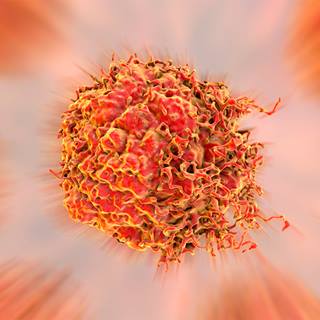Prostate Cancer - Localized

Overview
This article is for men newly diagnosed with prostate cancer that is believed to be localized to the prostate and regional lymph nodes. In some cases, more advanced disease may be managed with the treatments described here. Our goal is to give you the information needed to be well-informed when discussing treatment decisions with your providers.
Choosing among the various treatment options can be a difficult and anxiety-provoking process. Learning about prostate cancer will help you feel more confident in the treatment course you choose. Advances in the early detection of prostate cancer mean that the disease can be treated effectively in most men, who can usually anticipate a normal life expectancy. Additionally, many men may need no treatment, an initial strategy called active surveillance. There is much reason to feel hope and optimism for your future.
For some people, most of the information presented here will be completely new. Others may already be well-informed about prostate cancer and its treatment. Either way, please do not feel that this material has to be fully absorbed and understood in one reading. Reviewing portions of the material and discussing it with your doctors, family and other men with prostate cancer can make this information more useful. Your UCSF providers will be available to answer all your questions as you go through your decision-making and treatment. We are all here for you.
Understanding prostate cancer
The prostate is a walnut-sized gland that is part of the male reproductive system. It is located below the bladder and in front of the rectum. It surrounds part of the urethra, the tube that carries urine from the bladder to where it exits the body. The gland's main function is to produce fluid for semen, which nourishes and transports sperm cells.
When cells grow abnormally and form a mass, it is what we call a tumor. Some tumors are benign (unlikely to be life-threatening) and others are malignant (cancerous and potentially life-threatening). Over the course of a man's lifetime, some prostate cells may become cancerous. Sometimes the cancer is very small and confined within the prostate. In other cases, the cancer may extend through the prostate capsule (a situation called extracapsular extension, or ECE) or into the seminal vesicles (glandular structures attached to the prostate), or it may invade into adjacent structures. Additionally, through a process called metastasis, the cancer cells can spread outside the prostate to nearby lymph nodes or travel through the blood and lymphatic systems to more distant parts of the body, most often to the bones. Determining whether the cancer is confined to the prostate versus whether it has spread either locally or to distant sites is important to selecting appropriate treatment.
Localized prostate cancer refers to cancer that is confined to the prostate. Locally advanced cancer refers to cancer that may have spread outside the prostate – perhaps to regional lymph nodes – but not more distantly, such as to bones. There is hope for cure in both stages, but locally advanced tumors may require several types of treatment to achieve this. Advanced or metastatic prostate cancer refers to cancer that has spread far, typically to bones but other sites are also possible.
Prevalence of prostate cancer
Prostate cancer is the second most common cancer (following skin cancer) in U.S. men and is the second leading cause of cancer death in men. One in nine men born in the U.S. today will be diagnosed with prostate cancer during his lifetime. The risk of dying from prostate cancer, however, is much lower, at one in 41. Your individual risk depends on your risk factors. Continue reading this document to better understand your particular risk.
The American Cancer Society has estimated that more than 248,000 new cases of prostate cancer will be diagnosed each year in the United States and more than 33,000 men will die from the disease. The death rate for prostate cancer is twice as high for African American men as for the general population.
Most cases are diagnosed when men are in their 60s and 70s (average age: 66), although prostate cancer is sometimes detected in men in their 50s or younger. The good news is that the five-year survival rate for all stages of prostate cancer has increased from 69% to almost 99% over the past 20 years. These rates vary depending on the extent of disease. Reasons for this improvement include increased public awareness, earlier detection though screening with prostate specific antigen (PSA) blood tests, and advances in the treatments for this cancer.
Take time to make a treatment decision
Most prostate cancers grow relatively slowly, so immediate treatment is rarely necessary. Many men can safely take months to decide what to do. The decision process can be complicated. The chosen treatment can significantly affect your life, which makes it especially important to take time to educate yourself and confidently choose the approach that is most appropriate for you.
Take an active role
It is essential that you take an active role in learning about your condition, choosing a treatment, dealing with the treatment's side effects and monitoring your status. During the course of this process, you will be meeting and working with a number of doctors and other health care professionals. While you will rely upon your chosen team for treatment advice and administration, you should feel that you are leading the decision-making process. The roles of your various providers are to gather all the information on your cancer, to help you understand the risks your cancer poses, and to reduce uncertainty in the decision process.
You need to become fully informed about various treatments' pros and cons, request second opinions, and then decide what is best for you. Your decision will depend upon your particular situation and personal priorities. Learning about prostate cancer from a variety of sources, involving your family in the process, and attending a support group can help you to take charge and develop confidence and positivity. Ultimately, you need to choose the treatment plan you are most comfortable with.
Awards & recognition
-

Among the top hospitals in the nation
-

Best in Northern California and No. 7 in the nation for cancer care
-

Best in Northern California for urology
-

in NIH funding for urology research
-

Rated high-performing hospital for prostate cancer surgery
Diagnosis and Assessment
The tests performed during your diagnosis provide the information you need to understand your personal prostate cancer risk and prognosis. You cannot make an informed treatment choice without understanding your risk factors. This section describes how we diagnose prostate cancer and which factors we use to determine how aggressive it is.
Screening for prostate cancer
At UCSF, we believe in testing men so they know if they have prostate cancer, but that doesn't mean every man diagnosed should have aggressive treatment. Screening is the only way to detect high-risk, potentially life-threatening prostate cancer early, while it can still be cured.
Most prostate cancers in the U.S. are identified through the following screening tests:
- Prostate-specific antigen (PSA). This simple blood test checks levels of prostate-specific antigen, a protein produced by prostate cells. The higher the PSA level, the more likely prostate cancer is present. But PSA elevations can also occur in benign conditions, most commonly benign prostatic hyperplasia, in which the prostate enlarges, as occurs in most men over their lifetime.
- Digital rectal exam (DRE). For this physical examination, your doctor inserts a lubricated gloved finger into your rectum to feel for any irregular or abnormally firm areas. While most prostate cancers are detected by PSA screening, some cancers produce little PSA but are detected by DRE.
In some circumstances, your doctor may order a repeat PSA or other tests to help determine whether a benign condition led to an elevated PSA. These tests may include:
- Free PSA (blood test)
- 4Kscore (blood test)
- Prostate Health Index, or PHI (blood test)
- PCA3 (urine test)
- SelectMDx (urine test)
- ExoDx (urine test)
- MyProstateRisk (urine test)
- Multiparametric MRI (imaging test)
An MRI exam of the prostate is helpful and can allow for a more targeted biopsy.
A prostate biopsy should be performed only after several tests indicate sufficient risk of a clinically significant prostate cancer. A patient may not need all of these tests, however, before a biopsy decision can be made. Such tests determine who is most likely to have a higher-grade tumor that may be treated and allow us to avoid biopsy in those who don't have cancer or have very low-grade cancer that doesn't need treatment. At UCSF, we have decreased biopsy rates by about 40% using such tests.
If you have had symptoms of urinary infection or prostatitis, your doctor may prescribe antibiotics prior to further testing to eliminate the possibility of an infection being responsible for an elevated PSA. The decision to investigate further with a prostate biopsy is based on a combination of factors, including results of the PSA, DRE and other tests, family history, age, race and other medical conditions you may have. A biopsy should be performed only after discussing the procedure's risks and benefits with your doctor.
Diagnosing prostate cancer
Biopsy
Making a formal diagnosis of prostate cancer requires a needle biopsy. The tissue samples obtained from the prostate are then examined by a pathologist in a laboratory in order to confirm the diagnosis.
Transrectal ultrasound (TRUS) guided biopsy – A TRUS uses sound waves produced by a small probe placed in the rectum to create an image of the prostate on a video screen. The transrectal ultrasound image can sometimes provide valuable information about whether the cancer has reached the edge of or broken through the prostate gland capsule. The TRUS also provides an estimate of prostate size.
Whether or not the image reveals suspicious areas, the prostate is systematically biopsied for signs of cancer. After numbing the area around the prostate with a local anesthetic, your doctor will use an instrument called a biopsy needle to remove a series of tissue samples. The samples are then sent to a laboratory for examination. A minimum of 12 samples and up to 20 should be removed from different areas of the prostate and especially from any locations that appeared suspicious on MRI or TRUS. The procedure takes 10 to 15 minutes and usually causes only mild discomfort and a little bleeding. An antibiotic is usually given before and after the procedure to reduce the risk of infection, though there will still be a low risk of infection (1%).
Sometimes, the first biopsy doesn't identify any cancer, even when the patient's symptoms or PSA test results strongly suggest cancer. Repeat biopsies may be required in such cases. A prostate MRI is more commonly used in this situation than before a first biopsy, as are the other blood and urine tests described above, and a new test called ConfirmMDx, which analyzes genes in the normal-appearing tissue from the first biopsy. Your doctor can discuss these optional tests with you.
Grading the cancer
If cancer is found in the prostate biopsy sample, it is graded – given an estimate that reflects how abnormal the cells look under magnification. The more abnormal the cells, the more likely the tumor will grow aggressively. Determining the grade is essential for making decisions about treatment.
Gleason score
The most commonly used prostate cancer grading system is the Gleason system. A pathologist examines the cancer cells under a microscope and evaluates how closely the arrangement of the cancer cells in each biopsy sample matches that of normal prostate cells, using a scale that generally ranges from 3 (most like normal cells) through 5 (least like normal cells). Prostate cancers that appear to be low-grade are labeled Gleason pattern 3, intermediate-grade cells are labeled pattern 4, and the most aggressive cells are pattern 5.
Prostate cancers can be heterogeneous (having a mixture of different-grade cells), so two numbers are assigned to each cancer. The first number is the most common cell type and the second is the second most common cell type (for example, Gleason 3+4 means mostly pattern 3 with some pattern 4).
The Gleason system was recently simplified, so the Gleason grade is now summarized on a scale of 1 to 5 (least to most aggressive). Gleason 3+3 is Grade Group 1, Gleason 3+4 is Grade Group 2, Gleason 4+3 is Grade Group 3, Gleason 4+4 is Grade Group 4, and Gleason 4+5 or higher is Grade Group 5.
Accurate grading of the cancer is essential and depends in part on the pathologist's skill and experience, so it may be appropriate to get a second opinion on your Gleason score.
Staging the cancer
A prostate cancer's stage indicates how far it has spread. The commonly used staging system is the TNM system. This describes the extent of the primary tumor (T), the absence or presence of metastasis to nearby lymph nodes (N), and the absence or presence of distant metastasis (M).
TNM system
T categories – There are two types of T classifications for prostate cancer. The clinical stage is based on the DRE and imaging findings. The clinical stage is used in making treatment decisions. It is important to note that both the clinical stage and biopsy grade are estimates and may not reflect what is found if surgery is performed. (The second T classification type is the pathological stage, determined by closely examining the prostate after it is surgically removed.)
- T1 refers to a tumor that is not felt during a DRE or seen on imaging. T1a and T1b describe cancers found incidentally during a surgical procedure to relieve symptoms of benign prostatic hyperplasia. T1c cancers are those detected by a biopsy performed because of an elevated PSA. T1c is now the most common stage for newly diagnosed men.
- T2 refers to a cancer that is felt by the doctor during a DRE or seen in imaging studies and believed to be confined within the prostate gland. If the cancer is in half or less of only one side of the prostate, the stage is T2a. If the cancer is in more than half of only one side of the prostate, the stage is T2b. If the cancer is felt or seen in both sides of the prostate (not just identified on both sides by biopsy), the stage is T2c.
- T3 refers to a cancer that has extended beyond the prostate capsule or into the seminal vesicles, or both. This is determined through imaging studies or less commonly by biopsy. The stage is T3a if the cancer can be felt during a DRE and extends outside the prostate on one side but not to the seminal vesicles. If the cancer has spread to the seminal vesicles, the stage is T3b.
- T4 is for cancer that has spread to organs next to the prostate. Imaging tests can detect this more advanced tumor stage, which is uncommon in contemporary medical practice.
N categories – N0 means the cancer has not spread to any lymph nodes. N1 or N+ indicates spread to one or more nearby pelvic lymph nodes. (Nx indicates that regional lymph nodes have not been assessed.)
M categories – M0 means the cancer has not spread beyond nearby lymph nodes. M1a means cancer is present in distant lymph nodes. M1b means the cancer has spread to the bones. M1c means the cancer has spread to other distant organs. (Mx indicates that distant metastases have not been assessed.)
Another important consideration is the extent of the cancer in relation to the samples taken during the needle biopsy. If one of 12 needle samples shows prostate cancer, this suggests a smaller tumor than if eight of 12 show cancer. Likewise, the extent of cancer within each needle biopsy sample is sometimes assessed.
Imaging techniques
Imaging studies are often used to determine the cancer's location within the prostate, whether it has escaped the prostate, and, if so, where. Only higher-risk cancers require imaging to look for escape to other body parts.
The following imaging tests are most commonly used:
- Power Doppler ultrasound. While standard transrectal ultrasound produces images of the structure of the prostate and adjoining tissues, Power Doppler ultrasound can reveal blood flow patterns in tissue. This is important because cancerous areas sometimes show an increase in blood vessel density.
- Bone scan. This may show whether cancer has spread from the prostate to the bones. For the scan, a very small amount of radioactive material is injected into your bloodstream. This material is absorbed by diseased bone cells. The location of diseased bone can then be seen on the image. Although a scan may suggest that metastatic cancer is present, arthritis and other bone diseases can create a similar pattern. Very small metastases may not be detected by this scan. A bone scan is usually ordered only if there are signs of aggressive disease, such as an elevated PSA level (>15ng/mL), a high Gleason score, a large tumor or bone pain. In some cases, instead of a standard bone scan, patients have a PSMA PET scan, which is better at identifying smaller bone metastases. To confirm metastasis, a bone scan may be followed by other tests, such as X-rays or a bone biopsy.
- Computed tomography (CT scan). This study uses a rotating X-ray beam to create a series of pictures taken from many angles. These are put together into a detailed cross-sectional image. This scan can reveal abnormally enlarged pelvic lymph nodes or spread of the cancer to other internal organs. A CT scan usually is not ordered unless there is an elevated PSA or high Gleason score.
- Magnetic resonance imaging (MRI). This study is similar to a CT scan except that magnetic fields are used instead of X-rays to create images. MRI scans don't effectively reveal microscopic cancers. A multiparametric MRI uses special techniques to better demonstrate the extent of disease within the pelvis. MRI may be used before a biopsy to help set the target for the biopsy needles or after prostate cancer diagnosis to help determine the stage. Similar to CT, MRI can also identify enlarged lymph nodes. MRI is read according to the PI-RADS system: PI-RADS 1 and 2 scans are reassuring, indicating that high-grade cancer is likely absent. PI-RADS 3 is equivocal, and PI-RADS 4 and 5 scans indicate that a high-grade cancer is more likely present. Performing and interpreting an MRI of the prostate accurately requires substantial radiology expertise and should be done at a high-quality, high-volume specialty center, such as the one at UCSF.
- Axumin PET or CT scan. This scan can detect small amounts of prostate cancer anywhere in the body. The Food and Drug Administration (FDA) has approved it only for detecting recurrent prostate cancer after therapy. Axumin is still widely available but is gradually being supplanted by PSMA PET.
- PSMA PET/CT or PET/MRI. This is the most sensitive prostate cancer scan currently available (offered at UCSF and other locations). It can detect very small tumors anywhere in the body and may be used before treatment or in patients whose PSA rises after treatment with surgery or radiation. Learn more about PSMA.
The technetium bone scan and CT scan (see table below) are older, less sensitive scans. It is suggested to obtain the newer, more sensitive scans to better evaluate risk.
| Imaging Test Name | Description | Sensitivity | Availability |
| Transrectal ultrasound (often combined with Power Doppler) | Aims the biopsy needles | Varies | Urologist office |
| Technetium bone scan | Looks for cancer in bone | Poor | Imaging center |
| CT scan |
Looks for tumor in regional lymph nodes or bone |
Medium | Imaging center |
| Multiparametric MRI |
Better for prostate imaging than CT |
Good | Imaging center |
| Axumin scan |
Finds cancer anywhere in the body |
Very good | Imaging center |
| PSMA PET/CT or PET/MRI |
Finds cancer anywhere in the body |
Best | Imaging center |
Prostate cancer risk assessment
Prostate cancer represents a wide spectrum of disease. Some prostate cancers progress and need treatment, while others grow slowly, if at all, and can be managed conservatively with a system of careful monitoring called active surveillance. It is important to learn the characteristics of your cancer before making treatment decisions. There are many ways to determine prostate cancer risk, most of which incorporate information from several parameters, including the PSA, Gleason score (tumor grade) and tumor extent (number of cores involved and tumor stage on biopsy).
UCSF-CAPRA score
At UCSF, we use the Cancer of the Prostate Risk Assessment (CAPRA) score, a tool developed by our own prostate cancer specialists. This 10-point scoring system helps doctors assess the likelihood that your cancer will spread and whether it is life-threatening.
A CAPRA score is valid across multiple treatment approaches. It predicts an individual's likelihood of metastasis, cancer-specific mortality and overall mortality. The score is calculated using points assigned to:
- Age at diagnosis
- PSA at diagnosis
- Gleason score of biopsy
- Clinical stage
- Percent of biopsy cores involved with cancer
These variables are outlined in the chart below.
| Variable | Level | Points |
| PSA | 2 - 6 | 0 |
| 6.1 - 10 | 1 | |
| 10.1 - 20 | 2 | |
| 20.1 - 30 | 3 | |
| > 30 | 4 | |
| Gleason grade group | GG1 | 0 |
| GG2 | 1 | |
| GG3 - 5 | 3 | |
| T-stage | T1/T2 | 0 |
| T3a | 1 | |
| % pos bx | < 34% | 0 |
| ≥ 34% | 1 | |
| Age | < 50 | 0 |
| ≥ 50 | 1 |
How the UCSF-CAPRA score is determined. As an example, a 51-year-old man (1 point) with a PSA of 6.2 (1 point), a Gleason score of 3+4 (1 point), and stage T2c (0 points) prostate cancer involving two of eight (25%) biopsy cores (0 points) would have a CAPRA score of 3. A 48-year-old man (0 points) with a PSA of 15.2 (2 points), a Gleason score of 4+3 (3 points), and stage T1c (0 points) prostate cancer involving five of 10 (50%) cores (1 point) would have a score of 6. If your clinical stage is higher than T3a, you are still assigned 1 point on the CAPRA score under T stage.
What does the score mean? A CAPRA score of 0 to 2 indicates relatively low-risk disease. A CAPRA score of 3 to 5 indicates intermediate-risk disease. A CAPRA score of 6 to 10 indicates high-risk disease.
In summary, risk assessment is an important part of gathering information to make a decision on treatment. The CAPRA score is one of several risk assessment options and isn't intended to replace individualized doctor-patient decision-making. However, it does provide a straightforward tool for classifying disease risk – one that is useful in both patient care and research. Regardless of the specific approach taken, treatment must be guided by the risk that the cancer will spread. The CAPRA scoring system can offer a framework for discussions with your providers.
Genetic and genomic tests for localized prostate cancer
Genetic testing
A man's inherited genes predict his prostate cancer risk. For a long time, we have known that there is a family risk in prostate cancer. If your father or brother has prostate cancer, or your mother or sister has breast or ovarian cancer, you are at higher risk of being diagnosed with prostate cancer. To partially quantify that genetic risk, a germline test can be performed before a biopsy. This test of DNA from healthy cells can determine whether you have inherited genetic mutations, such as BRCA1 and BRCA2, known to increase prostate cancer risk. If the test shows you're low risk, you may be able to avoid a biopsy even if you have a slightly elevated PSA, while still being actively monitored for prostate cancer.
Genomic testing
If already diagnosed with prostate cancer, you may undergo another type of test for assessing your genetic risk. A genomic test of tissue from your biopsy or prostatectomy can look for somatic mutations, alterations in the DNA of the cancer cells themselves. Genomic tests measure expression of various genes that relate to how aggressive a cancer is likely to be. They indicate how rapidly cancer cells are growing and how genetically abnormal they are relative to normal cells.
Results from genetic and genomic tests can supplement what is shown by the CAPRA score, PSA, Gleason grade, clinical stage, imaging studies and other tests. They do not provide a yes-or-no answer as to whether a cancer will progress, but they add valuable information to help guide treatment decisions. They are especially helpful when the patient and his doctors are unsure whether active surveillance is appropriate for what appears to be a low-risk diagnosis. In high-risk cases, they can also help determine whether the cancer risk is high enough to suggest longer-term androgen deprivation therapy (ADT), which suppresses testosterone production.
Currently available tests include Decipher from Veracyte, Prolaris from Myriad Genetics, and Oncotype DX Genomic Prostate Score from Exact Sciences. There is some degree of overlap in what these tests provide, and the ideal use for each depends on the individual situation. Your doctor can discuss which test will be most valuable in your case.
Treatment Options
Deciding how to treat prostate cancer can be a confusing process. Each treatment has its own mix of benefits, risks and effects on quality of life. The good news is that several treatments have proved successful for many patients, either in providing a cure or keeping the cancer under control for years. However, your doctor may not be able to tell you which treatment to choose, because personal preferences typically play a significant role in the decision.
In addition to the tumor risk factors described above, that choice is influenced by factors such as:
- Your age and life expectancy
- Your general health and other medical conditions
- Cost and practical considerations
- Attitudes about achieving a cure or living with cancer
- Your needs, concerns, values and social relationships
- Your feelings about specific treatment side effects, which can include urinary incontinence and urinary irritation, erectile dysfunction, bowel problems, and other issues that will be discussed below.
You and your providers may choose a combination of the treatments described below.
Active surveillance
As previously noted, many prostate cancers do not pose an immediate risk to health and may not require treatment. Active surveillance is a way to monitor low-risk prostate cancer – cancer that is not an immediate risk to your well-being.
The ideal candidate for active surveillance has:
- A PSA at the time of diagnosis of 10 ng/mL or less that does not change much over time. A better way to interpret PSA is to calculate PSA density, or PSAD (PSA divided by the prostate volume). A PSA density under 0.15 is favorable, suggesting the cancer is less likely to grow.
- Ultrasound, MRI and physical examination (DRE) – or other test results – that suggest the cancer has not spread outside the prostate gland.
- Low-risk biopsy results, including a prostate biopsy Gleason score of 6 or less (no pattern 4 or 5). It is important that the biopsy is performed correctly: Enough of the prostate must be sampled to be sure the cancer is not large or aggressive. If the initial biopsy was not performed at a high-volume center and was not image-guided, another is usually warranted before finalizing a decision for active surveillance. These confirmatory biopsies are particularly important if the original biopsy was done outside an academic setting. An MRI is recommended before the biopsy to help target where samples are taken.
Carefully selected men with slightly higher-risk disease characteristics (such as low-volume Gleason 3+4) may also be candidates for active surveillance, particularly if imaging or genomic testing results are reassuring. You and your doctor can discuss whether you are a good candidate for this option.
If you choose active surveillance, you will visit your doctor for regular checkups. During these visits, you will undergo tests to find out whether your cancer has changed. The tests usually include:
- A PSA blood test every six months
- MRI scans, genetic testing of the tumor, and other advanced tests (some developed at UCSF) to better assess risk and the appropriateness of continuing active surveillance as treatment
- Repeat MRI, prostate biopsy or both every one to two years initially (sometimes sooner than one year) and then less frequently to monitor your cancer grade and volume
If the tests suggest your cancer is growing or becoming more aggressive, your doctor may recommend that you start treatment or consider an early repeat biopsy. But if changes are small or nonexistent, your doctor may advise that you can safely continue active surveillance.
Making lifestyle changes – such as improving your nutrition, reducing stress and getting more exercise – can also be part of active surveillance. A study at UCSF showed that men on active surveillance who made lifestyle changes had lower PSA levels and lower rates of treatment than men who did not make these changes. You may choose to join diet and lifestyle studies at UCSF or support groups as part of your active surveillance. Making healthy lifestyle choices can also lower your risk of cardiovascular disease – the number one cause of death in men with or without prostate cancer. Lifestyle changes are reviewed below.
Is active surveillance right for you?
There are some risks associated with active surveillance. They include a low risk of infection with every biopsy and a very low risk of cancer progressing in any one interval of surveillance. Sometimes men choose active surveillance for a period of time and then decide to undergo treatment.
Thousands of UCSF patients have chosen active surveillance to initially manage their prostate cancer. This is one of the largest groups of patients on active surveillance in the world. About one-third of these men receive treatment by five years and 50% by 10 years. The window of opportunity to cure prostate cancer is usually measurable in years or even decades. In fact, treatment results for these men appear to be similar to what would have been expected had they chosen treatment right after their original diagnosis. Based on our experience and those reported from other centers, the risk of significant cancer progression in the short to intermediate term, while not zero, appears to be very low.
Some men with risk factors – such as family history, genetic mutations and being African American – may still be candidates for active surveillance but need a more careful or intense surveillance regimen to make sure any early signs of progression are identified.
The most common reason for seeking treatment is a biopsy that shows the cancer is growing or becoming more aggressive in appearance (such as a Gleason score increase from 6 to 7 or more). Changes in PSA or cancer stage based on imaging results may also lead to treatment.
Over the years, active surveillance has emerged from a research concept to the preferred standard of care for most men with low-risk prostate cancer. Your doctor can answer your questions about active surveillance, and you can decide together whether this is a good option for you.
Radical prostatectomy
A radical prostatectomy is surgery to remove the entire prostate gland and seminal vesicles after a prostate cancer diagnosis is made. Sometimes nearby lymph nodes are also removed.
A variety of surgical techniques are used for a radical prostatectomy. It can be done through an "open" incision in the abdomen (radical retropubic prostatectomy) or through an incision in the perineum, the area between the scrotum and the anus (radical perineal prostatectomy). Most high-volume U.S. centers no longer favor these approaches.
Alternatively, a procedure called laparoscopic radical prostatectomy may be used. In laparoscopy, surgery is performed by making small incisions and passing specially designed telescopes and other delicate instruments into the body. Laparoscopic radical prostatectomy results in less blood loss, less discomfort and an earlier return to normal activities.
At UCSF, we perform laparoscopic radical prostatectomies using a surgical system called the da Vinci robot, which offers excellent magnification and surgical precision. In terms of controlling cancer control and preserving urinary and sexual function, outcomes are at least as good as those obtained via open radical retropubic prostatectomy. Other complications appear to be less common with the robot-assisted approach.
Subtle differences among these procedures for prostatectomy can be discussed with your surgeon. At UCSF, we use a robotic approach for the vast majority of procedures for the following reasons: the robotic approach appears to remove the prostate cancer as well as the open approach; it is associated with less blood loss, an earlier return to normal activities and fewer complications; and it may be associated with an enhanced ability to spare the neurovascular bundles that control erectile function.
Once the prostate gland and seminal vesicles are removed, lymph nodes may be sampled (see below) and the bladder is reattached to the urethra. Most men need to spend only one night in the hospital after laparoscopic surgery. A urinary catheter is left in place for about a week to allow urine drainage while healing takes place. In some cases, an abdominal drain (tube that drains fluid accumulation) may be in place for one or two days.
Radical prostatectomy allows, in most cases, for complete removal of the cancer. Once the prostate is removed, analysis of the tissue (a pathology report) can indicate how advanced the cancer is, what the risk for recurrence is, and whether additional treatment may be needed. It is relatively easy to follow men who have undergone radical prostatectomy to be sure their cancer is gone. Once the prostate is removed, the patient's PSA should fall to undetectable levels within six to eight weeks. Radiation therapy can be administered after surgery, if necessary, with some risk of additional side effects.
Patients who choose radical prostatectomy should be in good health, have a life expectancy of more than 10 years, and have discussed all available treatment options with their doctors. Some men with prostate cancer extending beyond the prostate gland may benefit from the procedure as well, frequently in combination with radiation or other treatments. Radical prostatectomy is occasionally an option when prostate cancer recurs after radiation or other treatments. This approach, known as salvage prostatectomy, carries higher risks of side effects and should be considered carefully.
Lymph node dissection
When prostate cancer spreads (metastasizes), it often first invades the lymph nodes near the prostate. For this reason, the lymph nodes close to the prostate may be removed during a prostatectomy so they can be checked for cancer. Lymph node removal is not necessary in all patients. It can cause lymphedema, a buildup of fluid in the fatty tissue just under the skin, though this complication is rare.
Nerve-sparing radical prostatectomy
The nerves and blood vessels (neurovascular bundles) that allow the penis to become erect run along either side of the prostate. To help a patient maintain the ability to have erections after surgery, either one or both of these bundles can be spared. Each bundle contains multiple nerve fibers, and in some cases, part of a nerve may be spared; nerve sparing is not necessarily an all or nothing choice. The best results are achieved if both bundles can be spared.
Young men who are sexually active and report having good erections before surgery are most likely to benefit from preservation of the bundles. In some cases, preservation of the bundles may not be advised due to the location or extent of the cancer. As the nerves run close to the prostate, preservation of the bundles in some men may risk leaving cancer behind. You should discuss the risks and benefits of nerve-sparing surgery with your doctor.
Side effects of radical prostatectomy
The most common side effects of the procedure are incontinence (leakage of urine, usually with stress or activity) and erectile dysfunction (inability to get or maintain an erection). The incontinence, though common early after surgery, usually goes away. Whether erectile function returns depends on whether the nerves surrounding the prostate can be spared at surgery, patient age and baseline function. Men who are older or already have erection problems are most likely to have erectile dysfunction afterward.
For more information, see our in-depth article on Radical Prostatectomy and our guide for managing erectile dysfunction.
Radiation therapy
While radical prostatectomy seeks to cure cancer by removing it, radiation therapy aims to cure the disease by killing cancer cells in place. Radiation can be given as external beam radiation therapy (EBRT), as brachytherapy (temporarily or permanently implanting radioactive "seeds") or as both. EBRT radiates the cancer from the outside to inside. Brachytherapy radiates from inside the tumor.
Radiation therapy is all about the radiation dose. Higher dose does a better job killing more cancer cells, but higher dose increases the risk of radiation induced side effects. New radiation hardware, software and technique have improved the ability to give a high dose to the cancer while minimizing the dose to healthy surrounding tissues. This has resulted in much improved cure rates and lessened side effects from radiation therapy.
External beam radiation therapy (EBRT)
With EBRT, radiation – usually in the form of X-ray photons – is focused from a source outside the body onto the prostate and, if needed, surrounding lymph node areas. In preparation for the therapy, internal markers (typically three gold nonradioactive seeds) are implanted in the prostate, using a procedure similar to prostate biopsy; they're used to help align and target the prostate with the radiation beam. A planning CT scan is then performed to locate the prostate gland in relation to the surrounding structures and organs. The resulting images are used to make a treatment plan that targets the prostate gland (and possibly the seminal vesicles or lymph nodes) while protecting healthy surrounding tissues (such as the bladder or rectum).
Most radiation today is given as a type of EBRT known as intensity-modulated radiation therapy (IMRT), in which the shape and intensity of several fine radiation beams can be varied during treatment to minimize damage to surrounding tissues. At UCSF, patients also benefit from image-guided radiation therapy (IGRT), where the prostate is imaged immediately before the start of each treatment session to verify and adjust the position of the gland for added accuracy. Stereotactic body radiation therapy, or SBRT (whether done on the linear accelerator or the CyberKnife robotic system), is a special type of IMRT/IGRT in which high doses of radiation are given over a small number of treatments (typically four or five).
The schedule for EBRT treatments varies. Treatment may be delivered in one of the following ways:
- Small doses per daily sessions (five days a week) over a protracted course of five to nine weeks (conventional radiation).
- High doses per session in four or five sessions delivered over two to three weeks (hypofractionated radiation). SBRT is a special form of hypofractionated radiation.
- An intermediate daily dose per session (five days a week), typically over four weeks (moderately hypofractionated radiation).
- With SBRT (sometimes using the CyberKnife robot) to administer a high dose over a small number of treatments (typically four or five).
Depending on your prostate cancer risk category and other individual or disease characteristics, your doctor may recommend conventional fractionation or stereotactic treatments. All treatments are delivered on an outpatient basis, with no hospitalization necessary. Conventional treatments typically last 10 to 15 minutes, while SBRT treatments take around 30 minutes. Patients receiving radiation to the lymph nodes (such as those with high-risk disease) or those receiving radiation after prostatectomy usually receive conventional fractionation.
In certain situations, such as high-risk prostate cancer, your doctor may recommend a combination of EBRT and brachytherapy "boost" (see below) to improve the likelihood of cancer control. In that scenario, the number of EBRT treatments will be reduced, typically to five weeks. Additionally, EBRT is sometimes combined with four to 24 months or more of hormonal therapy in men with higher-risk disease.
There is a great deal of discussion, and some highly misleading marketing, surrounding an alternative form of radiation called proton beam therapy. While it is a standard option, no clinical study has ever shown that proton beam therapy has an advantage over other forms of radiation in terms of cancer control, complications or quality of life.
Side effects. Common side effects during treatment include loose stool or diarrhea, frequent urination or defecation, a burning sensation while urinating, and fatigue. Medication or changes in diet can help relieve the symptoms, which usually resolve within a few weeks after treatment ends.
Less commonly, some men develop persistent or delayed side effects months or years after treatment. These include scar tissue in the urethra, fistulas (holes between the rectum and urinary tract, which can lead to chronic infections), blood in urine or stool, and secondary cancers of the bladder or rectum. Erectile dysfunction can develop over time, particularly in men who receive combination radiation and ADT. Because of the effect on sexual function, men who may want to father children in the future should consider sperm banking prior to treatment. While EBRT will not affect your ability to have an orgasm, it may affect your ability to ejaculate and reduce the force or volume of ejaculate.
Brachytherapy (seed implants)
Brachytherapy uses tiny radiation seeds, each smaller than a grain of rice, that are implanted in or around the prostate gland (or both) to destroy cancer cells. The seeds may be placed permanently in or near the prostate, or temporarily, through seed-filled narrow tubes inserted briefly one or more times for one or two days.
With a permanent seed implant (also known as low dose rate, or LDR, brachytherapy), the seeds contain radioactive isotopes, such as iodine-125, palladium-103, or cesium-131. The seeds are first placed inside thin hollow needles that are then inserted through the skin of the perineum (the area between the scrotum and anus); next, the needles are withdrawn, leaving the seeds inside the prostate. Seed placement follows a predetermined map, computer generated to specifically fit your prostate volume and shape. This is typically a two-step procedure: first, a transrectal ultrasound is performed to map the prostate, and then seeds are placed under either general anesthesia or spinal anesthesia on an outpatient basis. In cases of substantial prostate enlargement, testosterone-lowering medication is sometimes required to shrink the prostate before the seeds can be placed.
The temporary implant, known as high dose rate (HDR) brachytherapy delivers a larger dose in one or more sessions over one or two days in the hospital. Under anesthesia and ultrasound guidance, multiple hollow needles are placed through the perineum into the prostate. Then a planning CT scan is done and a complex computer program helps generate a treatment plan. The HDR machine houses a high-energy radioactive seed (iridium-192), which is attached to a wire. After a treatment plan is approved, the hollow needles are attached to the HDR machine and the radioactive seed is pushed automatically and systemically into each of these needles and then withdrawn when the appropriate radiation dose is delivered to the prostate. Treatment is typically delivered over several minutes. At completion, the hollow needles are withdrawn. If the therapy is being used to boost treatment, you usually get only one dose. If it is the definitive treatment, you may be given multiple doses.
For patients with lower-risk cancer, or selected patients with intermediate-risk cancer, brachytherapy alone may be sufficient. However, in many cases, a combination of radiation treatments is recommended. Patients with a high-risk cancer may be advised to have HDR brachytherapy to treat the prostate and EBRT to treat the prostate and the whole pelvis.
Side effects. Side effects of brachytherapy are generally similar to those associated with EBRT. Many men experience mild short-term issues, such as pain in the perineum, discolored urine (pink or bloody), difficultly starting urine flow, incomplete emptying of the bladder or increased urinary frequency. Erectile dysfunction may develop over time. A small percentage of men experience long-term side effects, which may include urinary urgency, urinary obstruction, and significant rectal or bowel irritation. Men who may want to father children in the future should consider sperm banking prior to the treatment.
Both EBRT and brachytherapy increase the risk of other cancers, especially bladder and rectal cancer, starting about five to 10 years after treatment. While the risk of a second cancer is increased relative to the general population, radiation-induced cancers remain a rare serious side effect.
Radiation therapy outcomes
The effectiveness of both brachytherapy and EBRT is indicated by how much your PSA declines. The lowest level of the PSA attained is referred to as the nadir. A nadir around 0.5 ng/mL is typically expected for men undergoing EBRT with conventional fractionation, while the nadir in patients undergoing SBRT or brachytherapy is typically less than 0.5 ng/mL.
It may take one to five years after radiation therapy to reach a nadir. About one-third of men who undergo brachytherapy experience a temporary rise in their PSA values six to 36 months after the procedure before the PSA resumes its decline. This "bounce" or "spike," as it's sometimes called, can be alarming, but it should not be interpreted as treatment failure. A similar spike may occur in a smaller percentage of patients who undergo EBRT, especially with SBRT.
The rates for successful treatment are lower for men with higher-disease risk (increased CAPRA score), and therefore these patients generally receive hormone therapy together with radiation (often brachytherapy boost with EBRT).
Hormone therapy with radiation
Prostate cancer cells need testosterone to grow. Hormone therapy aims to drastically lower testosterone levels to slow the cancer's progression. Although it does not cure the cancer on its own, hormone therapy improves the effectiveness of radiation for high-risk disease and is often recommended in conjunction with radiation therapy for men with intermediate- or high-risk localized disease. However, hormone therapy may have significant side effects. These include loss of libido (sex drive), hot flashes (feeling hot and sweating), changes in mood or memory, loss of bone and muscle density, body fat gain, and adverse effects on sugar or cholesterol metabolism. When offered as short-term therapy in conjunction with radiation, it is often well tolerated. How long a patient should receive hormone therapy remains controversial and depends on how aggressive his cancer is.
Learn more about hormone therapy.
Combined therapies
An increasing volume of literature suggests that for men with high-risk prostate cancer, the best treatment approach may be multimodal therapy. This involves some combination of techniques – surgery, radiation therapy and systemic treatment (such as hormone therapy) – depending to an extent on the pathology report, PSA outcomes and genomic testing after surgery. The multimodal approach has become the standard of care for other aggressive cancers, such as breast and rectal cancer. Radiation or surgery or both may also be appropriate for some patients with limited metastatic disease at the time of diagnosis. When surgery and radiation are combined, it is easier and safer to perform surgery followed by radiation rather than radiation followed by surgery.
Tissue ablation and focal therapy
Tissue ablation treatments destroy the prostate cancer through freezing or heating. These treatments can be applied to all or just part of the prostate (focal ablation). Whereas whole gland ablation has largely fallen out of favor, focal ablation has gained popularity. The two most commonly used energy sources are as follows:
Cryosurgery kills cancer cells in the prostate by freezing them through special needles that are inserted into the gland. The needles are placed under ultrasound guidance. This method is effective in curing cancer but can't treat lymph nodes and commonly causes erectile dysfunction if the entire prostate is treated. Urinary incontinence is a rare but possible side effect.
High-intensity focused ultrasound (HIFU) uses the high temperatures created by focused sound wave energy to kill cancer cells. While HIFU results over the years have been mixed, modern systems – such the one used at UCSF – allow real-time monitoring of tissue temperatures during treatment, improving outcomes.
Less commonly used ablation methods include interstitial laser ablation, electroporation (NanoKnife), vascular targeted photodynamic therapy, gold nanoparticle therapy, and others under development. Focal radiation (radiation to the tumor only) is used occasionally as well. Currently, there is little data comparing these technologies.
Who should have focal therapy?
Candidates for focal therapy must be carefully selected, most often based on well-performed, image-guided biopsy techniques (such as MRI-ultrasound fusion technology). Patients with intermediate-grade tumors visible in a single location on imaging (ideally away from the urethra or bladder neck) may be considered for focal therapy. Low-grade cancers can be treated this way but are usually more suitable for active surveillance. Some doctors feel that cancer close to the urethra can also be treated in this fashion, but there may be a higher risk of side effects or incomplete treatment. Some feel that additional candidates for focal therapy include patients with one dominant tumor as described above and a microfocus of low-grade disease elsewhere. These smaller cancer foci are followed through active surveillance.
Results of ablation therapies to date have been favorable, but the experience and time of follow-up are still limited. In addition, these patients must be evaluated carefully to avoid undertreating their cancer, and after treatment, they need to have periodic imaging, PSA assessment and at least one follow-up biopsy.
Does it matter where treatment is performed?
A large body of evidence shows that in the case of surgery for prostate cancer, surgical experience matters greatly. Medical centers and surgeons performing a high number of prostatectomies per year demonstrate better outcomes in terms of both cancer control and quality of life than those performing relatively low numbers. We don't have similar data regarding radiation outcomes, but performing brachytherapy well certainly requires expertise and experience, particularly in prostate ultrasound. Planning and administering EBRT effectively has many subtleties, which likely translate to better outcomes with more experienced doctors. No matter what the practice volume of specific surgeons or radiation oncologists, they should be able to discuss their own demonstrated outcomes both in terms of cancer control and quality of life.
When further treatment is needed
While prostate cancer diagnosis and treatment have improved significantly in recent years, the cancer can still recur. That's why it is essential that you and your doctor continue to monitor your PSA on a quarterly basis for some period of time, no matter how successful your treatment seems to be. Patients usually can consider a number of treatment options to treat or control recurrent cancer. Choosing among them requires a new decision-making process.
Why cancer recurs
Not surprisingly, studies show that the likelihood of recurrence is higher the more advanced the disease was when detected and the more time that has passed between diagnosis and treatment.
Recurrence may be related to the initial treatment type, but other factors are also involved, such as the original staging, Gleason score, extent of the cancer, and patient's age. (See section on risk assessment.) Elements in recurrence may include the following:
- Your cancer may have been understaged (meaning that it was more extensive than originally estimated), graded too low (meaning that, once the prostate was removed, the tumor showed higher Gleason scores than in the pretreatment biopsy), or both. Staging and grading underestimates have been discovered in up to one-third of pathology studies of the entire prostate following a prostatectomy. These issues may occur with treatments other than surgery but are not always identified unless the prostate is removed. The use of more refined and advanced imaging techniques, such as multiparametric MRI and Axumin PET/CT scans, have substantially improved initial staging.
- Your cancer may have been undertreated. Underestimates of the stage and grade can lead to undertreatment. In addition, sometimes a patient undergoes only a single treatment method that is unlikely to be effective by itself, even though his pretreatment scores indicated a higher risk category.
- Surgery may not have removed all of the cancer, or radiation therapy may not have completely treated it.
- The cancer's biology may make it likely to recur even after the best treatment. Some cancers, for example, have already escaped to other parts of the body at a microscopic level (not detectable even with PET/CT) at the time of initial treatment.
The PSA as indicator
The most common sign that the cancer was not completely removed or is recurring after surgery or radiation therapy is a persistently rising PSA. This should not be confused with the PSA bounce some patients experience following radiation therapy. In those cases, PSA levels will fall after an initial rise.
Not all patients with a persistently rising PSA will develop metastatic prostate cancer and not all patients will face the possibility of a life-threatening form of the disease. Indeed, some patients with a late, low-rising PSA may not require immediate treatment. The severity of the relapse can be determined by reviewing how soon the PSA started to rise after treatment and how quickly it is rising. This is frequently referred to as the PSA doubling time (PSADT), which is generally expressed in months.
Options for dealing with recurrence
With a persistently increasing PSA, the suspicion for recurrence increases. The most important factor in assessing your long-term outcome is determining the location of the prostate cancer cells producing the PSA. Advanced imaging techniques, such as MRI and PSMA PET/CT, are often helpful in learning where the cancer is located, and in the case of post-radiation recurrence, repeat biopsy may be required.
If a man underwent surgery as an initial treatment, revisiting the post-operative pathology report may help to identify what contributed to the recurrence. If there was still cancer present (positive margins), the cancer was aggressive (higher Gleason scores were detected), or genomic profiling of the tumor showed high-risk features, several options are available:
- EBRT to the prostate bed with or without the pelvis.
- EBRT accompanied by hormone therapy. The duration of hormone therapy will depend on the PSA level just prior to radiation and to a lesser extent on the Gleason score and staging of the cancer.
- Systemic treatment using hormone therapy, other treatments for those at risk for metastatic disease, or a combination.
- Active surveillance if the remaining cancer appears insignificant. You and your doctor can decide whether to intervene more aggressively and, if so, when.
If the cancer recurs after radiation, a salvage prostatectomy may be an option. However, when the surgery is performed after previous treatments, there is a greater likelihood of incontinence or impotence. Further radiation or cryosurgery are also options, but again entail greater risks than when radiation is used as the first-line treatment. On the other hand, cancer that recurs after focal therapy can usually be treated for cure with either prostatectomy or radiation, or in some cases, repeat focal therapy.
If you're seeking additional or different approaches, you may be eligible to participate in an appropriate clinical trial (a study using human volunteers to evaluate a promising new treatment). You can research this with the help of your doctor.
Joining a clinical trial
Clinical trials are medically supervised, carefully controlled patient studies that attempt to determine whether a proposed new treatment is both safe and effective. Clinical trials also look at whether a new treatment can lead to better outcomes than existing treatments. These studies may involve researchers from a variety of disciplines, such as general medicine, medical specialties, genetics, biology, chemistry, engineering and psychology. Clinical trials are conducted at medical centers around the country, and participants are often actively recruited.
New treatments are continually being developed for prostate cancer. Many prostate cancer trials are designated for patients with a rising PSA after local treatment or for those with advanced, metastatic cancers. However, there are also many trials for men with less aggressive cancer, such as the active surveillance trials at UCSF. We also conduct trials of neoadjuvant treatment, which are medications given before surgery for higher-risk prostate cancer. Several new treatments and approaches show promise – some as simple as lifestyle changes in diet and exercise.
Funding sources for clinical trials include the National Cancer Institute, Department of Defense, universities and medical centers, private research foundations, pharmaceutical and biotechnology companies, and various combinations of these groups.
Clinical trials usually occur in phases:
- Phase I studies determine safe and therapeutic dosage levels.
- Phase II trials determine whether the new agent is beneficial.
- Phase III trials extend the experimental treatment to a larger group. Results are compared with results from a control group, in which participants receive a standard therapy or a placebo. After a successful phase III trial, the new treatment will still need formal approval from the FDA for use in appropriate patients.
Participation considerations
Clinical trials can offer hope and a chance for you and society to benefit from a promising new treatment, but they have their risks. Any patient considering participating in a trial should ask himself and his treating doctor the following:
- Do I fit the criteria for inclusion?
- How might I benefit from participating?
- What are the probable side effects?
- What if I'm placed in the control group that doesn't get the treatment under evaluation? (In many trials, those receiving the placebo will cross over later on and receive the active treatment.)
- How large is the control group versus the group receiving active treatment?
- What happens if I quit or am dropped from the trial?
- What happens if my condition gets worse while I'm in the trial?
Accessing clinical trials at UCSF
UCSF is currently conducting research in four main areas:
- Identification of genetic and lifestyle factors that predispose men to clinically significant prostate cancer
- Discovering alterations in genes and proteins to improve current prostate cancer treatment
- Developing new therapies for men with recurrent widespread prostate cancer
- Preventing progression of early-stage untreated disease
To learn more, search for a trial or contact us, visit Cancer Clinical Trials at UCSF.
Complementary and alternative medicine
There is an important distinction between complementary therapies and alternative therapies.
- Complementary therapies, such as exercise and diet changes, are undertaken in addition to conventional medical treatments. Health care providers are often supportive of complementary therapies, depending on your particular situation.
- Alternative therapies are undertaken instead of conventional medical treatments. Some of these may be helpful for some people, but most are not well-studied and none are well-regulated. Misleading websites and false advertising abound. You should be extremely careful about choosing nonstandard treatments instead of treatments that have been evaluated in clinical trials with published results.
Many therapies can fall into either category. Some interfere with standard medical treatment or cause serious side effects, so be sure to inform your doctor if you are considering any of these therapies. Lifestyle changes are likely to be helpful in both reducing the risk of getting prostate cancer and controlling its progression. UCSF is a leader in coordinating clinical trials of diet, exercise and stress in patients with prostate cancer. In addition, every prostate cancer patient treated at UCSF receives access to a nutritionist or dietitian to help in planning a healthy diet and to address dietary issues that may arise during treatment.
This article was written by UCSF medical experts Peter R. Carroll, MD, MPH, Matthew Cooperberg, MD, MPH, and Osama Mohamad, MD, PhD, and UCSF patient advocates Nathan Roundy and Stan Rosenfeld. It was last reviewed in February 2022.
This information is for educational purposes only and is not intended to replace the advice of your doctor or other health care provider. We encourage you to discuss any questions or concerns you have with your provider.
More treatment info
-

Active surveillance for prostate cancer
This method of monitoring low-risk prostate cancer involves regular checkups, biopsies and blood tests to make sure the patient’s cancer isn't changing.
Learn more -

Radical prostatectomy
The procedure removes the prostate gland and attached seminal vesicles.
Learn more
Where to get care (1)
Related clinics (4)

Osher Center for Integrative Health
 2
2

















